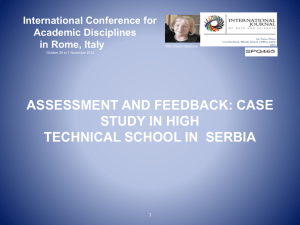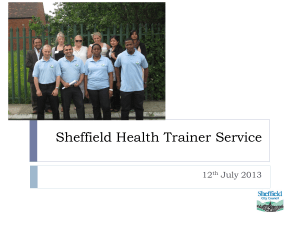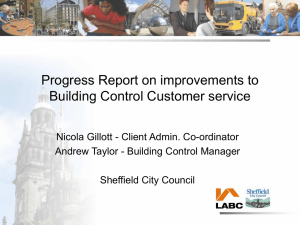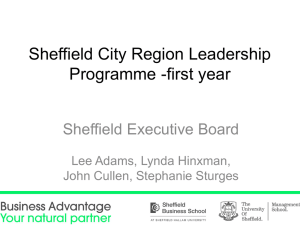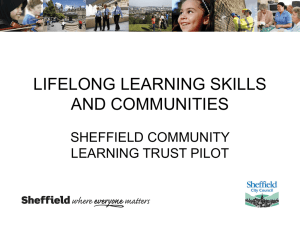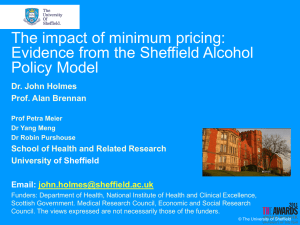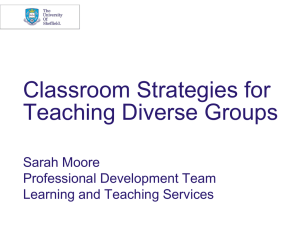New Europeans in central Sheffield
advertisement
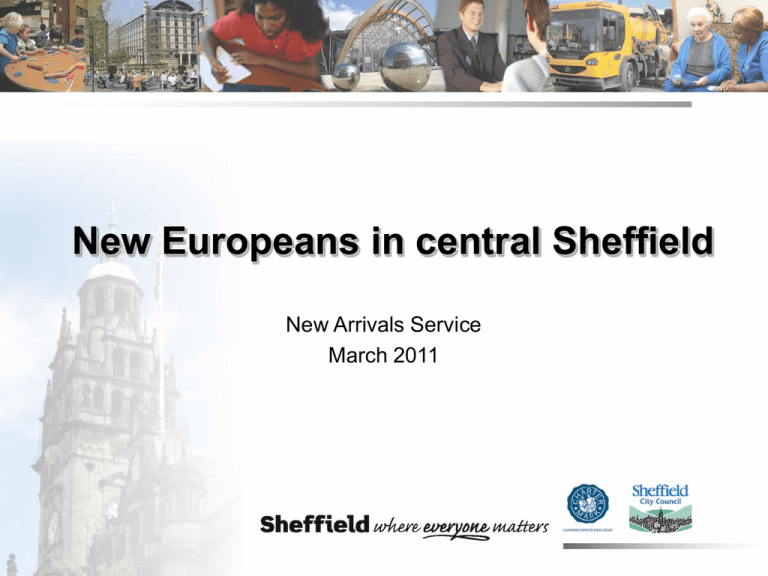
New Europeans in central Sheffield New Arrivals Service March 2011 New Europeans in Central Sheffield • Background & Context • Methodology - Local data & information - ‘Sheffield & You’ survey • Survey outcomes • Reporting & Using Findings Background & Context • 2004 & 2007 – accessions of 12 new member states to the EU: - Czech Republic - Estonia - Hungary - Latvia - Lithuania - Poland - Slovakia - Slovenia - Romania - Bulgaria - Malta - Cyprus • Accession state nationals settling in Sheffield since 2004 – mainly from Slovakia and Poland • Slovak Roma populations in the East and North East of Sheffield, other accession state migrants predominantly in central areas of the city • New Arrivals Service – completed 2009-10 study focusing on East & North East Community Assembly areas (Slovak Roma populations) • 2010-11 study (Nov 2010-Feb 2011) focused on accession state nationals in Central Community Assembly area, & Ecclesall & Nether Edge wards Background & Context • New Arrivals Service – completed 2009-10 study focusing on East & North East Community Assembly areas (Slovak Roma populations) • 2010-11 study focused on accession state nationals in the central areas of Sheffield (Central Community Assembly & adjoining wards) • Community Assembly focused – Sheffield governance Methodology National & Local Information DATA SOURCE(S) Worker Registration Scheme – new registrations (Sheffield postcode data) UK Border Agency National Insurance Number – new applications (Nationality & Sheffield postcode data) Department for Work & Pensions & UK Border Agency International Passenger Survey (estimates of immigration and emigration) Home Office Local Migration Profiles - Sheffield & South Yorkshire Yorkshire & Humber Regional Migration Partnership Interpretation requests by language (Sheffield health services) Sheffield Community Access & Interpreting Service (SCAIS) Sheffield Pupil Level Annual Schools Census ( PLASC - pupil first language data) Children, Young People & Families Service (Sheffield City Council) First Point interpretation requests – EU languages (April 2010 - December 2010) First Point (Howden House) Address data – casework involving EU migrant households (Central Community Assembly Area) Private Sector Housing Team (Sheffield City Council) Health Visitor caseloads - EU migrant families (Central Community Assembly Area) Rivelin & Sheaf Multi-Agency Support Team (MAST, Sheffield City Council) Dziennik Polski (Polish language magazine) commercial distribution points Dziennik Polski (London) A8 nationals in central Sheffield • • Locations (highest density to lowest): • S2 - London Road/Nether Edge • S6 - Walkley and Hillsborough • S7 & S11 - Ecclesall Road/Ecclesall Ward Nationalities • Polish & Slovak most common • Smaller numbers of Czech, Hungarian and Lithuanian nationals Worker Registration Scheme (2009) - applicant nationality profile (Sheffield & Y&H region) Local data – some examples… Commercial distribution points - ‘Dziennik Polski’ magazine (Sheffield, 2010) © Crown copyright and database rights 2011 Ordnance Survey 100018816 Local data – some examples… 3799 4000 3500 Number of Requests 3606 3475 3202 3000 Czech 2500 Hungarian Latvian 2205 2000 Lithuanian 1500 1000 Polish Slovak 664 500 0 2004-2005 2005-2006 2006-2007 2007-2008 2008-2009 2009/2010 Financial Year A8 languages interpretation requests, 2004-2010 (Sheffield Community Access & Interpreting Service) Local data – some examples… 2 2 2 5 2 Bulgarian 2 Hungarian Latvian 5 Lithuanian Polish Romanian Slovak Slovenian 28 PLASC Schools Census 2010-11 - pupil first language data, A8 languages (Central Community Assembly Area) Methodology ‘Sheffield & You’ survey • Non-Roma accession state nationals – less contact with services, far less data available • Survey method – selected to facilitate as wide a range of participation as possible (limited project resources) • Survey translated into Polish, Slovak, Hungarian, Lithuanian & Czech (% most common WRS registration nationalities) • Survey asked respondents for information on the following aspects of their life in Sheffield: – Family circumstances – Migratory history and intentions – Education & skills – Housing – Employment – Use of health and/or advice services in Sheffield Methodology ‘Sheffield & You’ survey • Web and paper-based survey completion available (both translated) • Translated flyers advertising web survey • Targeted distribution of paper surveys – including via schools (EMTAS – guided by PLASC data) © Crown copyright and database rights 2011 Ordnance Survey 100018816 Methodology Successes & Challenges • Limitations of national produced data – indicative only • Local information from service providers – useful supplement, but not consistently collated/reported across partners & limited to those accessing services • 21 survey responses - 20 via schools, all paper-based. Effective point of community access, although survey information biased towards parents with children in Sheffield schools • Low web survey response rate – would benefit from targeted, online marketing of survey participation & more intensive, longer term work with employment agencies ‘Sheffield & You’ survey outcomes Demographics • Respondent nationalities 1 2 Polish 1 • • Slovakian Slovak Roma Lithuanian • Czech 3 14 • 16 of 21 respondents were female Majority aged 25-34 19 of 21 indicated English language ability Other second languages included Russian, Czech (Slovak respondents) & French 20 of 21 in Sheffield with spouse/partner & children at school ‘Sheffield & You’ survey outcomes Employment • • • • • • 16 of 21 in employment Employment types included skilled machine operators (2 Polish respondents), food production (5 from all nationalities), social care (1 - Slovak), manual labour (3), academia 2 had arranged employment in Sheffield before leaving the UK 8 used employment agencies to find current role 12 employed for over 1 year in current role Underemployment common – if in same industry/sector as country of origin, not working at same grade in UK 1 3 <3 months 7 3-6 months 1-2 Years 2+ Years 5 Length of time in employment in the UK ‘Sheffield & You’ survey outcomes • Settlement intentions – All survey respondents indicated planned long-term settlement in Sheffield (2+ years or permanent) • Views on local areas – Positive experiences in local areas – School location, community safety & good transport links most important aspects of a local area • Local service usage – Advice services used appropriately & as needed - First Point, CABs – Awareness of different health services - GPs, A&E – Information on available services found via friends &/or family and translated service information (leaflets, flyers, posters etc) Reporting & Using Findings • • • • 7 Community Assemblies – 4 wards & 12 elected Members each Some devolved decision-making & associated resources – eg parks, street cleaning, libraries etc Strong emphasis on involving local people & local organisations in decision-making – ‘You Say’ & ‘You Choose’ sessions Annual Community Assembly Plan: - local priorities (via consultation) - allocation of CA resources - plans for ongoing consultation by CA - details of role of statutory services in taking local priorities fwd Reporting & Using Findings Central Community Assembly Plan 2010-11 Priorities • Activities for young people • Education, jobs & incomes • Environment • Good shops & local services • Traffic & parking • Community support & people getting on together • Health • Community Safety EXAMPLE… Things for young people to do What? Where? Who? Who raised it? Targets Budget Timescale Youth Choose – an event-based grant fund for young people to use Central CA wide Central CA To support activities and oneoff events that young people want £10,000 November 2010 Central Community Assembly Plan CHILDREN & YOUNG PEOPLE – Increasing take-up of free school meals: • May 2011 changes for A8 nationals will mean increased levels of entitlement to free school meals - are schools aware? • How can take-up be promoted to eligible A8 families? • What are potential benefits of increased take-up? – Activities for young people: • Do A8 children and young people take part in mainstream activities? To what level? • Are providers effective at facilitating participation by A8 children & young people? • What can be learned from initiatives in other areas – for example, the ‘Blast Off’ football initiative (E & NE areas – Activity Sheffield & SY Police)? – Youth Forums: • Are A8 young people currently represented &/or involved in Youth Forums? Central Community Assembly Plan COMMUNICATION • • How does the Community Assembly communicate with local accession state national populations and ensure their involvement in decision-making? Can access routes that were successful for the study, such as schools, be used for consultation & communication by the Community Assembly? COMMUNITIES & LOCAL AREAS • • Accession state families’ priorities for their local areas of residence in part reflect those of other local residents – community safety, good transport links etc – and many intend to stay permanently. Are accession state populations included in local area planning and consultation activities? Questions….. Sheffield City Council Asylum Team 0114 273 6612 asylum@sheffield.gov.uk

